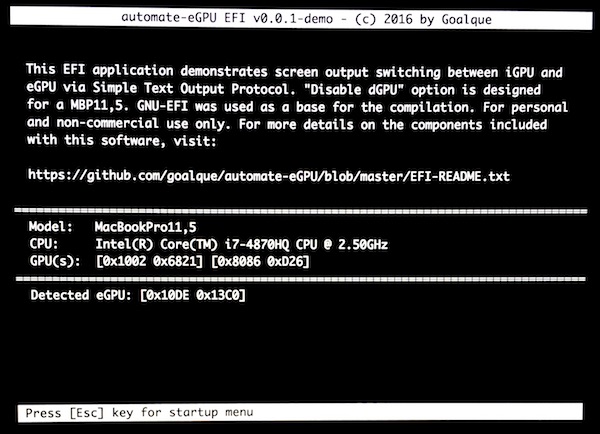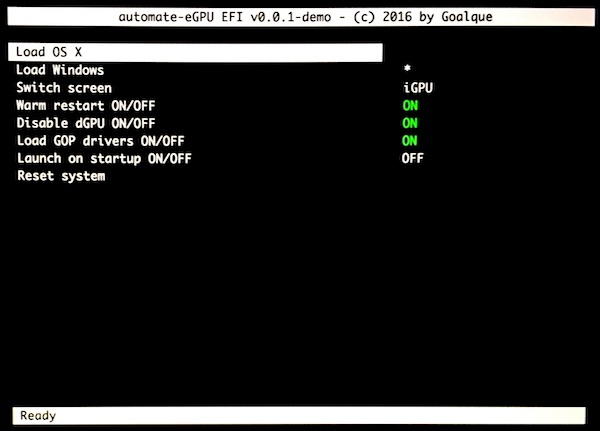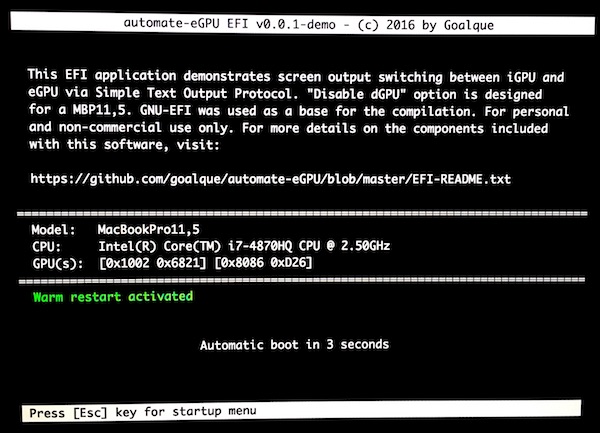
euqlaog
-
Posts
0 -
Joined
-
Last visited
-
Days Won
27
Content Type
Profiles
Forums
Downloads
Posts posted by euqlaog
-
-
This quote from my GitHub repository might help with the demo version:
"When the [-a] mode is turned on, Nvidia eGPU connected to nMP Bus 0 (port 5 or 6) works, but Thunderbolt Bus 1 or 2 (ports 1-4) require one additional restart and shut down without eGPU."
-
The development version is confirmed to work with the nMP. May require "warm restart" option which is not supported in demo version, and you have to use the HDMI interface of the nMP in the beginning.
-
The eGPU ROM must be UEFI compatible, otherwise screen switching doesn’t work. Incorrect ROM might work, but better to use the original. One restart (F1) is required after "Load GOP drivers" is set to ON. Thanks for testing!
-
You can extract your VBIOS using GPU-Z and name it “eGPU.rom”. If it doesn’t work through the TB connection, search and download the correct one:
-
 1
1
-
-
2 hours ago, pixxelpusher said:
I like the look of this!! Is it possible to select different OS X versions and Windows versions using the boot screen manager? I normally have a few different versions of each running.
Also, would a boot screen like this work on a Mac Pro desktop to give an internal PC video card boot options (not just a black screen)? That would be pretty cool. I've been using BootChamp to load Windows but that requires loading into OS X first.
For now, the application assumes that you have solely OS X or Windows Boot Camp partition, or both of them. Maybe in the future.
I have designed this for Thunderbolt Macs only, and in order to show the eGPU boot screen, you likely need a TB2 Mac. Majority of the PC UEFI cards should work. I’ve tried Gigabyte and EVGA. 2011 Mac mini supports GOP, but its firmware wasn’t able to output text through the eGPU. 2014 Mac mini is supported.
-
On 18 April 2016 at 9:40 PM, juniordiscart said:
Hi @goalque
I know you are probably really busy, but I'm eagerly awaiting the updated version of your script / app you hinted at a few pages back. How is that project coming along? Is there a way to follow progress on it? Or will it be a bit more closed-source as to avoid scams such as the Bizon box?
Anyway, still a big thanks for your contributions to this community and the great script! Running it myself right now on a Macbook Pro Mid 2014 with 750m + GTX960 on OS X 10.010.4.
I’ve been working on a completely new application - eGPU boot manager for Mac computers. Installation script is not required as with rEFInd which invokes bless for the changing of the default boot partition. Settings can be done within the app. For more information, see
https://www.techinferno.com/index.php?/forums/topic/10057-automate-egpu-efi-mac-bootscreen-on-egpu/
You can download the demo version here:
https://github.com/goalque/automate-eGPU/releases/download/v0.0.1-demo/bootx64.efi
Don't use a riser and try OS X reinstallation. Please post hardware problems on this thread:
https://www.techinferno.com/index.php?/forums/topic/6224-diy-egpu-macbook-experiences/
-
Ok, then it’s a Thunderbolt Display:
https://support.apple.com/kb/SP642?locale=en_US
You need a direct connection from the eGPU interface. I guess also that your adapter doesn't work.
-
57 minutes ago, Lossy said:
just rereading, do you mean connect directly to the card using HDMI to thunderbolt, and not connecting to akitio? Currently the iMac and external is connected to the akitio through thunderbolt
Cinema display has only mDP port. You have to use the display interface of the external GPU (such as HDMI, DP, DVI).
And then,
Go to System Preferences > Displays > Arrangement
Drag the white bar at the top of the blue box. -
-
Thanks for the feedback! This app could be a base for full Mac eGPU automation in the future, without needing to disable the SIP in recovery mode. Maybe I will focus on AMDs since they don’t need web drivers. It’s very likely that future Macs have Polaris GPUs. I already got R9 Nano working on 10.12, surprisingly also the acceleration part with the “Baffin” personality.
@t00h0t
I appreciate your interest in beta testing. Your Macs are actually the ones in which the EFI app has not been tested. I already have a partner, but I will think about it. I’m a busy software engineer as well, so the progress of this project has been slow.I assume that the demo will be ready for release this weekend.
-
 1
1
-
-
It’s a common belief that Macs need a “Mac EFI” in order to show the boot screen or Apple logo. As to new TB Macs, I had a theory that this is not true. There is always a protocol how the computer talks with the GPU. Macs are not an exception to this rule. After browsing of several hundred pages of specification white papers how EFI works, I got an idea that finally took a form of EFI application.
The development version, which is not available for public, is nearly a full-fledged eGPU boot manager. Push the power button of your 2014 Mac mini or nMP, and the custom welcome screen appears on your eGPU monitor, without having to go through Apple's startup manager by holding down the Option key. If the internal HDMI interface is in use, select “Switch screen”, and the screen output is switched between integrated and external graphics in real time. My EFI app makes also Maxwell cards (such as GTX 980 / GTX 980Ti) Mac friendly with the Nvidia’s original PC UEFI rom. R9 AMDs are compatible out of the box.The demo application has the following restrictions:
- Doesn’t include “Launch on Startup” option
- The UEFI driver is downloaded into memory from the USB stick when you power on your Mac whereas the development version reads the driver from the eGPU on the fly
- “Load Windows”, “Load OS X” and “Disable dGPU” and “Warm restart” are restricted for a MBP11,5.
- You still need to use automate-eGPU.sh script in OS X
The application detects your Mac hardware: Model Identifier, CPU, integrated/dedicated GPUs, and eGPU.
I explain the menu options briefly,
- Load OS X. Loads OS X immediately if "Warm restart" is turned off. If once selected, the app remembers the selection on next boot and [*] is shown at the end of the row.
- Load Windows. Loads Windows immediately if "Warm restart" is turned off. If once selected, the app remembers the selection on next boot and [*] is shown at the end of the row.
- Switch screen. Values [iGPU or eGPU]. If the value [eGPU] is activated output on startup and "Load GOP drivers" is turned on, automate-eGPU EFI welcome screen appears on the monitor which is connected to an external GPU.
- Warm restart ON/OFF. When booting from cold power state, the app waits for 5 seconds, then restarts the Mac before chain loading to Windows/OS X. If menu option (1) or (2) is selected after this is turned on, additional restart is not carried out but 5 seconds delay is still valid before booting to the default OS of this application (different than Apple's default).
- Disable dGPU ON/OFF. Disables dGPU completely on next boot when turned on and activates iGPU.
- Load GOP drivers ON/OFF. Loads eGPU.rom and creates eGPU.efi which is loaded on next boot.
-
Launch on startup. Value [ON] will force Mac to boot automatically from the USB. Remember to turn this off or choose "Reset system" to have normal boot behaviour.
F1 = Cold restart
F2 = Shut DownThe UI is programmed from the scratch by calling Simple Text Output Protocol methods, no dependencies on GRUB or rEFInd. I like to keep things simple.
Install procedure is straightforward:
1) Format an USB stick in OS X Disk Utility (Choose Erase, Format: MS-DOS (FAT), Scheme: Master Boot Record)
2) Create a folder structure in Finder as follows:
EFI/Boot/bootx64.efi
EFI/Boot/eGPU.romwhere eGPU.rom is your VBIOS file. The app detects if the ROM contains UEFI section. If not, “Switch screen” doesn’t work.
3) Power on Mac with eGPU connected, hold down Option key and choose "EFI Boot" disk.
I don’t see much practical advantage in implementing Apple’s startup manager via eGPU, since all the Thunderbolt Macs have integrated or dedicated graphics for this purpose. Well, I was curious, so I did it anyway.
I noticed byte flipping when I compared the PCI binary path in closed clam-shell mode vs lid open. This observation led me to reconstruct the PCI path to point to eGPU, restarted the Mac by holding Option key down, and Apple’s native boot screen was mirrored to the eGPU monitor with a PC UEFI card. No Mac EFI. If the path is not correct byte by byte till the end, there is a high risk that your Mac may remain into black screen loop. So this feature is not included in demo.
That’s enough about boot screens. I promised Optimus automation for a MBP11,5, and it is provided as “Disable dGPU ON/OFF” option. You will see black screen about 10 seconds, but the internal display is activated as soon as Windows has loaded.
Remember that you use this demo app at your own risk, it’s not optimized and there are likely bugs. I don’t have time to provide support. I’m not responsible if your Mac won’t boot. This proof-of-concept app is free and for personal use only.
https://github.com/goalque/automate-eGPU/releases/download/v0.0.1-demo/bootx64.efi



-
 7
7
-
You need an external monitor and set that as the primary display.
-
-
19 hours ago, iddinmx said:
has anyone tried installing the script nvidea driver on the new MacOS Sierra 10.12 Dev Preview?
At present, 10.12 is confidential pre-release seed software, and as a developer I recall that we are not allowed to talk about it much before public beta.
-skipdriver option enabled acceleration and eGPU screen output even though the script hasn’t changed for 6 months.
5 hours ago, burrlin said:According to http://osxdaily.com/2015/10/05/disable-rootless-system-integrity-protection-mac-os-x/ I need to disable System Integrity Protection first, correct? or no?
Correct.
5 hours ago, burrlin said:From what I understand the goalque script should detect OS X product and build, and automatically download and install correct Nvidia web driver, sounds great! Should I uninstall old drivers?
Not necessary.
5 hours ago, burrlin said:So, download goalgue to desktop, open up Terminal and then execute the commands below?
chmod +x automate-eGPU.sh sudo ./automate-eGPU.shand thats it?Yes. Download anywhere you like and run from there.
-
2 hours ago, 360precision said:
When I run the install script I just get stopped at the "Thunderbolt device is connected, but no external GPUs detected".
Means that the eGPU doesn't appear in the I/O registry, and signifies a hardware issue. Please check that all the power connectors are plugged in properly. Try also a different TB cable/port.
-
Macs released before late-2014 don’t support TB hot plugging. Apple says that it works with all 2014 and later models, but mid-2014 MBP has actually the same model identifier as the late-2013 MBP.
-
1 hour ago, justintime said:
My 2015 MBPr also has a Radeon 370X.
An important detail. With the molex-to-barrel mod everything should work out of the box on Windows 10 Boot Camp, which has built-in AMD drivers.
-
I hope it's not bricked. If 2015 iGPU only MBP, he must delay the startup.
-
Drivers are bound to a specific version of the OS X and the script installs the correct one. It’s up to Nvidia if we’ll see Pascal support on OS X.
-
1 hour ago, pixxelpusher said:
Thanks for the reply. So what OS X should I be running with your script? No I have never manually edited any kexts, wouldn't know how. I just followed your steps on the first page.
Can you look at the Terminal info I posted, is there anything there you can see causing the error? Any other code you can give me to get it working? Thanks.
Yes, there is an error message:
installer: The upgrade failed (The Installer encountered an error that caused the installation to fail. Contact the software manufacturer for assistance.)
I’ve never seen this. Nvidia web driver installer failed for some reason. Try sudo ./automate-eGPU.sh -uninstall, restart the Mac and run again sudo ./automate-eGPU.sh
If still the same, update to the latest OS X Yosemite version which is 10.10.5 (14F1808).
-
@Rootes
The script does not support HDMI audio.
Better stick to latest OS X versions. Nvidia offers only beta drivers for Maxwell cards and infinite loops are not surprise. Apple’s security update 14F1021 is a good example of what you described. I don’t know about 10.10.3 14D136 but could be the the reason. Another common reason is manually edited kexts.
By the way, GTX 780 still beats GTX 980 in OpenGL (Valley benchmark) due to Nvidia’s optimizations for Kepler architecture. If your purpose is gaming on OS X, Maxwell cards won’t give you any boost.
-
Of course you have to run the command in the directory where the script is located.
-
 1
1
-
-
On 24 April 2016 at 8:22 AM, shirazigs said:
My computer becomes so slow, specially when I'm playing a video on the internet even my mouse moves so slowly. At the beginning I hadn't any problems, but after restarting my computer, the problem began to start !!!!! Do you guys have any idea, how to fix that?
if you’re using only CUDA accelerated apps ->
-
 1
1
-
-
He forgot to press enter.


automate-eGPU EFI - Mac bootscreen on eGPU
in Apple eGPU discussion
Posted
You can shut down the Mac with the F2 key and restart with F1 after welcome screen is closed with ESC. No need to force shut down from the power button.
My partner verified today that script's [-a] mode is not necessary with the development version. Demo version is not tested with the nMP. So please don't enable [-a] mode, you can turn it off by typing:
sudo ./automate-eGPU.sh -m
Restart the nMP by holding option key down, the EFI app should detect the eGPU if it's connected to Bus 0.